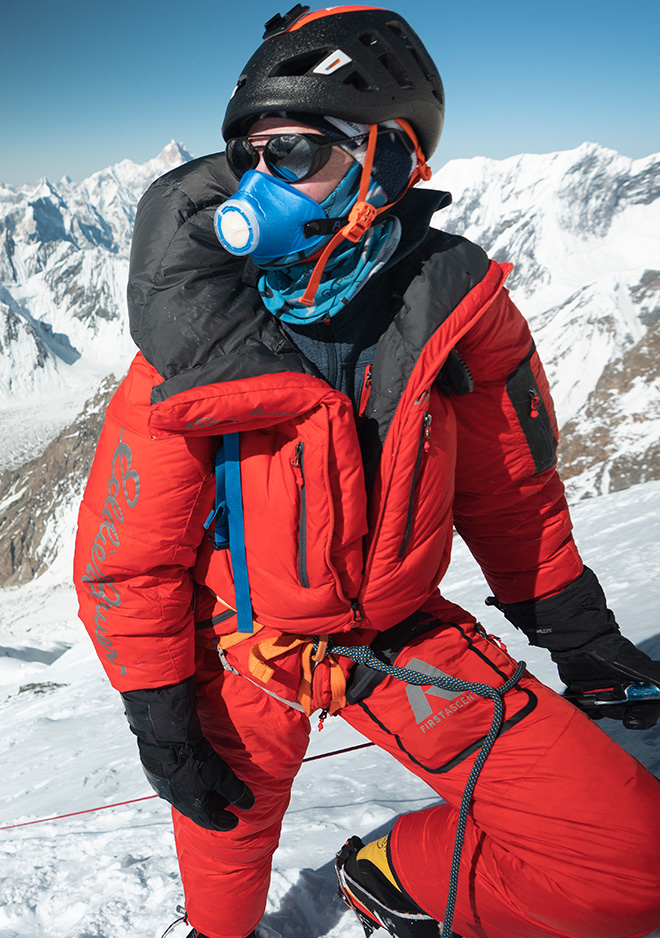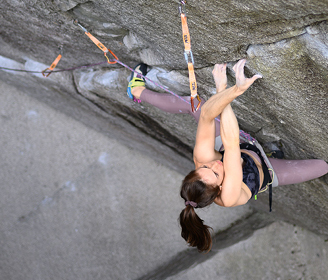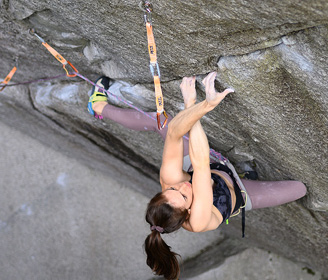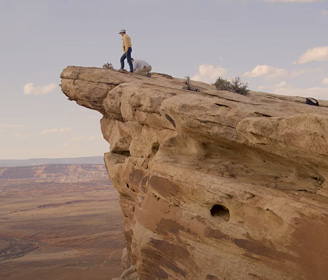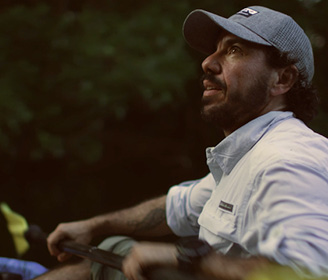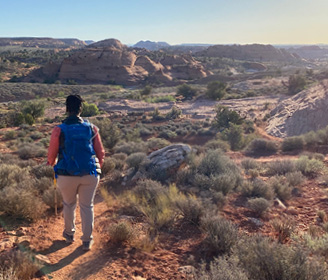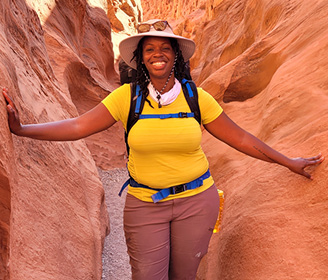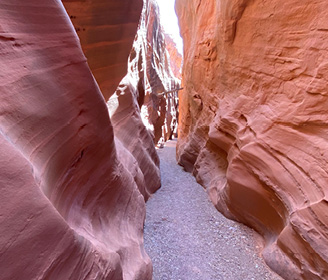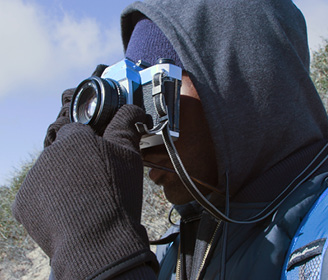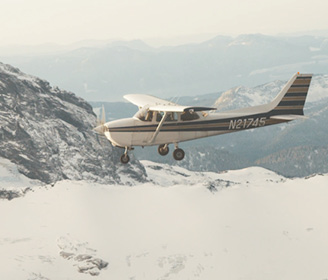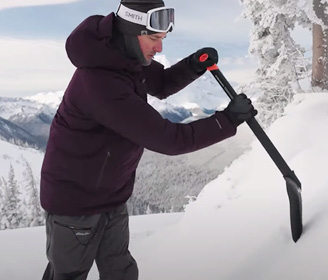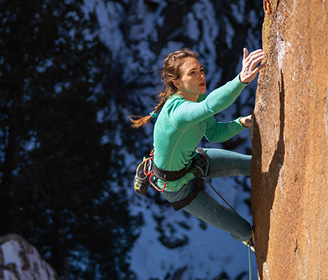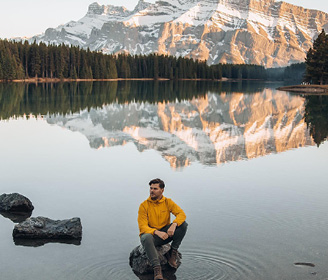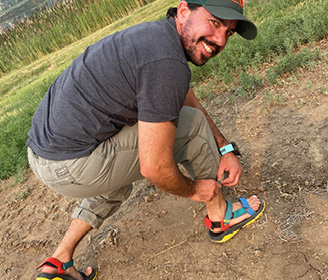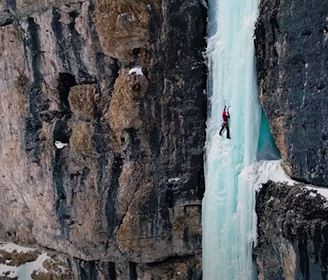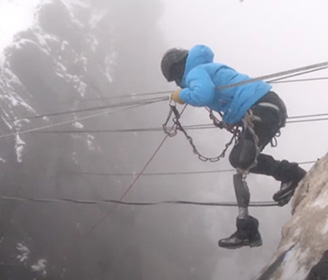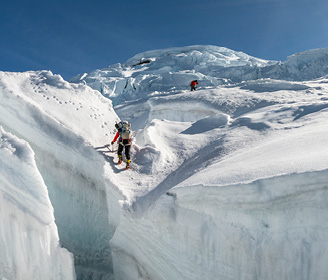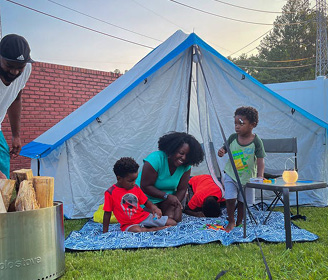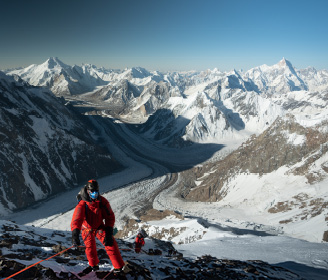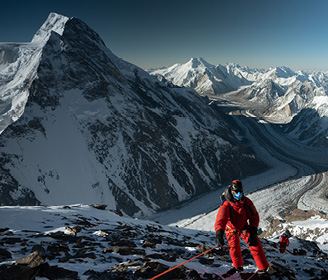Have you ever considered bouldering as your next adventure but not known what bouldering truly is? Ever wondered what the difference is between bouldering and rock climbing? Eddie Bauer Rock Athletes Katie Lambert and Ben Ditto who have crushed walls all around the globe are here to answer all of the internet’s most asked questions about bouldering.
Watch the video above!
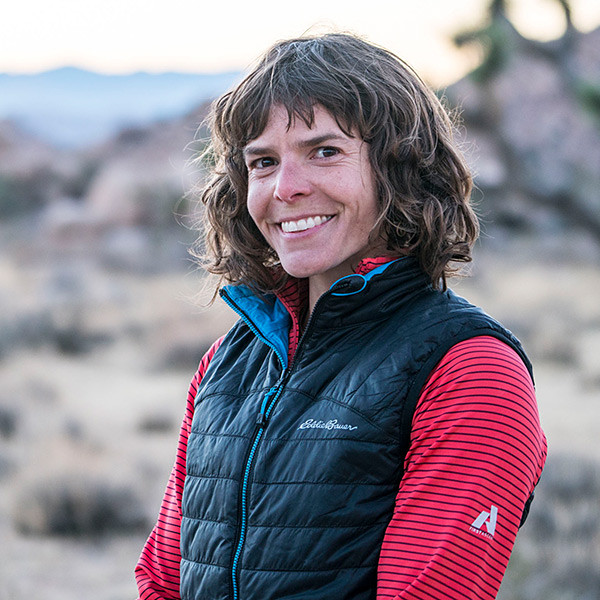
KATIE LAMBERT
Eddie Bauer Rock Climbing Guide
A free climber with a maximum strength-to-stature ratio, Katie Lambert has crushed big walls around the globe, from Yosemite and Zion to Picos de Europa and the Cirque of the Unclimbables. Trading short sport routes for legendary big walls, in 2006 Lambert migrated west to Yosemite National Park and since then has established herself as one of the world’s premier female free climbers
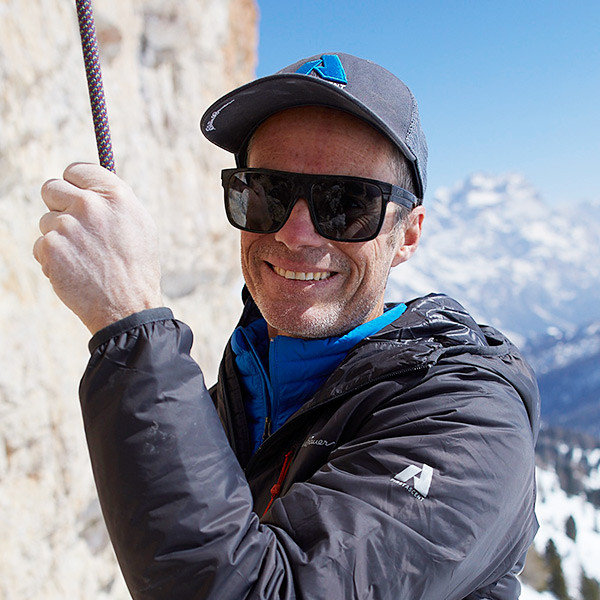
BEN DITTO
Eddie Bauer Rock Climbing Guide
After three decades of itinerant van residence, Ben Ditto is now living in the climbing epicenter of Bishop, CA. From Baffin Island and the Patagonian Andes to the high Himalayas, the talented photographer has climbed with and captured the world’s best rock stars at the very limits of their discipline. His images have appeared in Climbing, Rock and Ice, and Alpinist, among other places.
- What is bouldering Ben?
- Bouldering is rock climbing on boulders.
- What are boulders?
- They are rocks that are standalone rocks. That are usually you don’t need a rope. They are not so tall that you need to get too crazy with safety equipment or anything like that. You can just go out there and climb these sittings, and it’s kind of a cool sport. ‘Cause you don’t really need much gear. You just go out with your friends and find a nice quiet spot and start climbing up these things.
- How are bouldering problems graded?
- Bouldering problems are graded a little differently than route climbs. Boulder problems originally were started on the B scale. So it was like B one, B two, B three, but at some point in history, a man named John Sherman, came around and got really into bouldering and his nickname was The Verm, and he created the V-scale. So now boulders or V zero to V16 I believe.
- And that’s–
- V Zero being easiest, V16 being the highest, hardest level. It’s up to typically the first essentialist. The first person to climb that boulder to give it a grade. Sometimes it’s also consensus grades. So, the community chimes in and says what they think the grade is.
- It’s a sliding scale. If I do a brand new boulder problem, the first ascent, I might propose a grade. But then Katie, comes along and does it finds better beta. And then she thinks it’s easier then everybody thinks that I overgrade stuff. So it’s just a, a slippery slope as a first essentialist you’re going out on a limb, proposing a grade but you do the best you can based on your experience
- It’s really just like serves as kind of a guide for you as the climber or the boulder to know kind of what you’re getting into or what you could expect .
- How do you get better in bouldering?
- You just go bouldering a lot. You know, part of getting better at bouldering means being bad at bouldering. So you just go out there and you suck and you just can’t get up. And it’s like working a math problem and you’ve gotta just keep working it and you brush the holds and you can’t seem to get them clean enough. And really you’re just too weak. But as you do it more and more, you get stronger at it and you learn the techniques a little better. Your footwork gets better. Your psychological game gets better. Next thing you know, you’re a better boulder. What’s the difference between bouldering and rock climbing? And when you’re bouldering, you don’t use ropes. I think that is like basic answer that everyone’s looking for here. Bouldering, you just go out there. No ropes, no hardware. You just climb these things in your climbing shoes and chalk bag. You use a crash pad. Rock climbing, you get out the ropes. You get out of the harnesses. You climb to these amazing heights where you would certainly die if you fell. Yeah bouldering, you’re not in that situation. You just stay low to the ground and keep it safe.
- So how high can you boulder?
- As high as you’re comfortable jumping down. Bouldering requires judgment. You have to know how high to go. And fortunately, we’re all humans we have this instinct baked into us, we can’t help. You start getting too high, you’re gonna get really scared. And that’s a good thing to keep in mind. Just pay attention to your instincts when you’re out there. A good rule of thumb is a don’t go very much higher than you are tall. Like let’s just start with that as like a max height to boulder. But even within that you gotta size up your landing and make sure that it looks safe.
- Well, that’s how high can you boulder ties in, pretty good to the next question.
- Which is how to fall in bouldering?
- It’s nice to have bouldering pads. Bouldering pads, basically like a nice soft mat. Similar to like a gymnastics mat pretty light to carry. You can carry them on your back. People often ask. What are those crazy beds you’re carrying around? And we like to joke that, like we’re using it to go sleep in the woods or something. But basically, you want to fall like a cat like land on your feet, land square on your feet.
- Absorb the momentum with your body. And if that means you need to do a somersault and roll off or something like that. People do all kinds of things. Different gyms teach different techniques. Main thing remember that any type of climbing you’re doing, whether it’s bouldering, whether it’s rope climbing, it’s a constant game of assessing the risk and mitigating it. And this should be happening in your mind and in your conversation with your partners all the time.
- How to read bouldering routes?
- Learning to read the rock is an art in and of itself. I mean, if you show up at a popular bouldering area, at a popular boulder problem it’s gonna be covered in chalk. Most likely, unless it rain the night before and it’s gonna be pretty easy to see it. But inevitably, there’s going to be some subtlety, that’s hard to figure out. Sometimes you’ve got to get your face really close to the rock, just spot those footholds and really really break down the minutiae of how exactly do I do this. If it’s really hard for you, it’s going to be a challenge to read the sequence that you’re looking for.
- I’d say the hardest thing typically is finding the feet. Usually the hands are very well chalked but it’s not like climbing on the moon board or something like that. Where it’s like, your feet are tracking. You can use anything that’s on the rock, getting up close like Ben, said, looking for like the subtleties, and the undulations of the rock, or just being creative, having like you’re an open mind when you approach is really helpful. And then also, sometimes the chalk tolls aren’t necessarily always the best holds. As a smaller person, I’ve found a lot of alternative beta and it’s usually consisting of holds that were not chopped. So it’s like not the standard beta, but just like frustration of not being able to do something, leads to the patience of trying to figure it out, leads to eventually finding a way typically. Next question, how to spot while bouldering? That’s a good one. ‘Cause they see a lot of people out at the boulders, spotting their friends your hands release up. You’re watching your partner. I like to keep an eye on like their feet in their butt and not totally paying attention to what they’re doing with their hands. And just keeping an eye on the lower half of their body. ‘Cause I wanna guide them down to the mat. You’re not trying to catch someone. You really just trying to soften their fall and guide them onto the mat. But the biggest thing I see is thumbs are out. People are spotting, their hands are open like this. And if your partner, falls on you in like a awkward way right, you’re gonna get your thumb bent backwards. You can break your thumb. You can do some soft tissue damage. So, spot like this, spot with your thumbs and that’s like the biggest takeaway I think from this is make sure you are protecting yourself when you’re spotting but you’re also doing it to help guide them back down to the pad correctly.
- Yeah spoons not forks, spoons not forks. Part of the artist spotting means making sure that you have pads underneath the climber. And sometimes that means you’ve gotta move pads around as a team. And somebody keeps their arms up and they’re spotting. And then somebody else is moving pads around underneath. And part of that means you wanna have a nice smooth surface, just like in the gym. No seams, no hard edges to break ankles on that sort of thing. You wanna make sure the pads are tightly squeezed together. So there’s no cracks or anything there. And then, you know, somebody’s gotta be maintaining that all the time, while somebody else is spotting the climber with their hands. Just to try to deflect them, keep them from landing on their head, keep them upright. So that when they land, there they’re on their feet. You’re not trying to catch them, just deflect them.
- How do you train for bouldering Katie?
- Bouldering, it’s real powerful style of climbing. You’re using a lot of like finger strength. It can be really hard on the hands. Typically, and climbing your weakest link is your fingers. So getting stronger fingers for bouldering is gonna be helpful. If you’re new to bouldering, if you’ve never done it before you don’t necessarily need to be training for bouldering. You just need to be going out and bouldering. Just getting out and climbing, getting in different types of movement, climbing on different types of rock, if you have that option from like granite to sand stone. You’re gonna start to learn different types of movement. What different texture feels like. And how you can like use your feet. Use body positions on different styles.
- What do you wear when you boulder?
- I wear comfortable, lightweight clothing. That’s appropriate for the season that I’m in. And if it’s really cold I’m gonna be in a big puffy jacket and some pants and long underwear. But if it’s really hot, I’m gonna be wearing shorts and just a tank top or no shirt. It’s pretty versatile. You can wear whatever you got around the house I mean, sometimes we’ll see people out there bouldering after work and whatever they were wearing at work. And so it’s pretty basic. You don’t need anything fancy.
- Yeah I like to wear stretchy types of pants when I boulder. Clothes that just allow for greater movement, tights are really good. Like Ben said, it’s always kind of, it’s appropriate to dress for the weather. So if you’re bouldering in the summer, you could wear shorts. But if you’re bouldering in the winter, you know, for sure you want to be bundled up, you don’t want to restrict your movement.
- Should you wear socks when bouldering?
- No, no simple answer no. No, you don’t need to do that.
- Don’t do it .
- How do you care for hands while and after bouldering?
- Well, that’s a good one. The first thing that comes to my mind is you know, the rock around here, especially a lot of the granite and some of the volcanic rocks really sharp and it can snag on your skin. And so you’ll get these little snags and it might not seem like a big deal, but over the course of a couple hours of bouldering, that snag has gotten bigger and bigger ’cause the rock keeps pulling on it. So we’ll carry a little like maintenance kits around that have sandpaper and nail clippers in them. So you can cut off the little snag of skin and then sand it down at the sandpaper. So that it’s a nice, smooth surface. I guess another thing is it’s really important to make sure you warm up your hands and your fingers. ‘Cause you can blow a pulley or do some other kind of ligament damage in your fingers if you’re not warmed up correctly, especially in the colder months. So that means just starting really easy. So you get out of your car, you head up to the boulders, you circuit around on some V zeros and V ones. And then if you’re progressing through the grades then slowly kind of work your way up to like project.
- How to overcome fear of falling?
- I think it’s important to not get ahead of yourself. So it’s easy to get like really excited about something especially if it’s something new to you. And you wanna like really rush into it and kind of like try the hardest things or try the tall things. But if you are limited in your experience and you’re going to be getting yourself into some situations that you’re probably not going to be that comfortable with almost like a cat up a tree. Don’t be swayed by peer pressure. So just go at your own pace.
- When you show up to a new boulder problem and you’re looking up at it. And you’re trying to figure out where the holes are, and where you’re gonna stand, what the footholds are and how you’re gonna get up that thing. The crucial element, that needs to go into that research you’re doing is how do I get off that thing? ‘Cause you, the point is to climb up to the top of it and then you’ve got to be able to get down. So the first step, really when you’re scouting out a new boulder problem, is to find the down climb and go ahead and set your crash pad up below the down climb and climb up the back of the boulder. And then you get to the top and you can look over at the top holes and you can see what all those things look like. And that really goes a long way to giving you confidence so that you can try those hard moves download, get to the top. And you know, what your escape route is going to be like. So, yeah like Katie, said, sometimes out in the Buttermilks here, people top out these boulders and then they don’t know how to get down and then they get stuck and that’s problematic, you know, that means you’ve skipped ahead of what you need to be thinking about.
- How to wear a chalk bag while bouldering?
- A lot of like real hardcore boulders, won’t wear a chalk bag. And it’s just either their personal chalk bag or chalk bucket, which is a bigger style chalk bag. And I just leave it on the ground. You can tell, I think a lot of times at the bouldering area, if someone is more of a route climber because they will always have their chalk bags on them, strapped around their waist. That’s how I roll. If you’re gonna be doing something that’s like pretty low to the ground or kind of steep and you’re falling on your back or the, the chalk bags like dragging open and maybe you don’t actually wanna wear it. You can just leave it on the ground. How long is a typical bouldering session? That kind of ranges.
- Yeah, it just kinda depends. I mean, you can go out for just a little bit, blow off some steam and say, hey, to some friends and having a nice evening out or you can go out all day and the boulders and take a picnic. I mean if you’re really wondering about how long you can perform, like how long can I expect to be climbing my hardest in a session? I mean, there’s not that much in the tank when it comes to the energy systems that are related to trying hard. So you kinda just have to be patient with that and you can expect to really be able to boulder hard for like an hour or two. But then after that it’s just diminishing returns.
- What does brushing holds do in bouldering?
- Cleans up that sloppy grease that your friends leave behind after they’re done trying to.
- And all of the caked up chalk. A lot of times the chalk can get really caked in on their holds and it can make the texture feel a little bit more slick. Even though the chalk is there to prevent slickness.
- Boulderings, you know. On one level kind of all about conditions. And sometimes those holes are small and slippery and you need to clean all the moisture and chalk residue off to be able to get satisfactory burn on it.
- What do I need to start bouldering?
- Basically, just shoes and a chalk bag.
- And somewhere to boulder
- Why do people scream when bouldering ?
- Why do people scream and Kung Fu I mean, you’re really channeling energy and screaming. I scream when I boulder either because Katie has done something wrong Or because I really need to focus. And when I yell, it’s kinda of like a karate yell where you’re just focusing all that energy into this one specific moment. And yelling the yell really does help me. It’s just kind of a manifestation of trying to focus. I think
- I think so too. It’s also like in Kung Fu right? You’re doing it as like you’re conjuring up your cheek ’cause you’re like trying to execute that move. So a lot of times maybe you hear people not necessarily only screaming but like making noises, like huh something like that. And that’s like the latching of the move. That’s like the execution of that energy that you’re trying to put forward and catching that move. And then the scream ummh yeah. Ditto out here, can let out some really crazy screams almost like growls into screams and I’ll do it a little bit. I don’t probably do it as much now. I know for me, it’s like, it’s almost as a way to block out all of the other noise that’s going on in my head of like, you’re too pumped, you’re gonna fall. You don’t have the whole, you can’t do it. Like all this nonsense that you start to tell yourself I’ll scream so that I don’t hear it so that yeah, I can just focus on what I’m doing. That brings us to this next question.
- What is a dyno in bouldering?
- Dyno is short for dynamic movement. It’s an explosive movement where there’s two different types, really of dynos. There’s one hand dyno, where you latch the next hole with one hand, which I think is like the easier of the dynos. And then there’s the double handed dyno, where you throw us off the hold and you like latch up to the next hole with both hands. That one for me has always been the hardest.
- Yeah, and that one in particular, all four points are off. So it’s also known as the flying squirrel. It takes a lot of dynos, really require learning the motion of it. I mean, if you aren’t really that accustomed to athleticism and doing like really coordinated movements with all your lambs, they’re hard to learn but they’re cool to learn. So you can seek that out in the gym and learn how to dyno.
- What is hand tape for in bouldering?
- Usually just to cover up some splits or tears that you’ve gotten in your tips or in the creases of your fingers. Sometimes if people are bouldering up cracks, they’ll take the backs of their hands to protect them from that. But in generally when you see people with tape when they’re bouldering is cause it got some little hole, or some tear, or some split that they’re trying to cover up.
- If I’ve got my fingers all taped up and I look like I’ve been in some sort of battle, it lets my friends know where I’m at in my session. And they know like I’m not really taking it seriously anymore.
- Dead ass done.
- It’s an indicator that I’m done basically. I mean, if you got your tips all taped up like you might as well just go get a beer, forget about it.
- How to prevent forearms from getting pumped while bouldering?
- You really don’t actually get that pumped in bouldering because it’s a shorter duration that you’re exerting effort. Usually what happens is you just don’t have the strength to make the move. And so you fall, you don’t typically fall in bouldering because you’re cramped.
- Yeah, if you do one boulder problem at the gym chances are, you won’t get that pumped. But if you do one bouldering problem jumped down, do another one immediately jumped down, do another one immediately jumped down. You see where this is heading. You’re gonna start to get pumped. If you want to avoid getting pumped, just rest a long time between boulder problem attempts.
- How long does it take to progress in bouldering?
- Well, I don’t know, like this is different for everyone. Some people are just natural born talents.
- Yeah and progression is also really personal. I mean, it’s a, like you know we all want to focus on numbers and grades and stuff like that. But really you kind of have to ask yourself what does it mean to be better? If I could climb V10 in the gym and I go outside and I can’t climb V five it’s because the techniques are different and you gotta just take your time and learn each situations technique. And each type of rock. Every time we switch locations and it’s different rock there’s a little bit of a learning curve required where all of a sudden, you know we’ve been at home climbing our local boulders and then we get to a new spot and then we can’t climb the same grade there. And that’s really common with climbing where and I think that’s part of what keeps it interesting is there’s always something new to learn.
- How often can I boulder?
- I mean I can boulder as often as you want, honestly. Especially, if you live in a place where there is bouldering whether it be rocks outside or a climbing gym. We will start to see though pretty quickly like, let’s say you’re going bouldering, three days in a row. Well, your third day, like you’re not gonna be as fresh or as good as your first or even second day. Like you’re gonna start to get to plead it again and start to get tired. So, I mean, that’s kind of personal preference. Like if you’re trying to just exhaust yourself you could basically do it everyday that you want to do it. But if you’re actually trying to get better at it ummh, I would say like three times a week or something like that is a good number.
- Yeah, I think to one way to answer that question is to ask yourself, what’s your goal? And if you’re trying to climb one hard boulder problem that you need to be optimally strong for every time you go to it. Then you can climb that you can climb two days, two or three days a week. So you wanna have some rest days in between. But yeah, if you’re just getting started and it’s just fun and you want to go to the gym every day, all week like for the evening after work, then you should do it. You’re gonna feel it in your arms big time. And so you’re gonna want to factor some rest in there sometime. And, and you know, one rest day is really hardly ever enough. So–
- Much like young.
- Yeah, you should think about having like a couple of good rest days in there. Maybe if you need to get out and burn some steam, you can go for a nice power hike or, you know, go for a run or something like that.
- Okay, last question here.
- How can I find places to go bouldering?
- The first place, if you’re in a city would be to find your local climbing gym, look at the pictures online, see if, does it look like a modern gym? Is it look really old school? If it’s the only option, it doesn’t matter. But a lot of gyms have, a lot of cities have multiple climate gym options these days, maybe one is better for group climbing. Maybe one is better for bouldering. You know, if you’re just sitting in your living room and you wanna find the best boulders. Just start searching for on the internet. Rock climbing, It’s just kind of this one big package and all the little sub genres just fit in there. I boulder just strictly for the enjoyment of it, but then I also boulder because it helps me in the other types of climbing, I do.
- I also like bouldering for the social aspect of it because it is something that you can go out with a group of friends and do, but you can also go do it by yourself at any time you don’t, you don’t need a partner. You don’t need a crew of people to go out there if you’re comfortable with.

